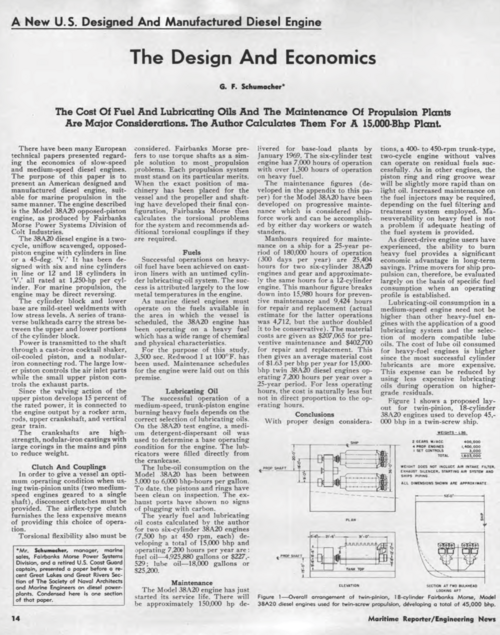isayyo2
Lurker alert
- Joined
- 24 November 2011
- Messages
- 1,034
- Reaction score
- 1,873
Creating this thread to hopefully uncover more information about the 38A20 family of opposed-piston diesels developed in the late 1960s.
What I know so far:
Courtesy of Lufkin Foundry and Machine Company's magazine Lufkin Line, we discover 38A20 started development by 1966 and had planned to go to sea in the "Falcon Class Tanker" ordered by Falcon Tankers Inc. and chartered by the Military Sea Transportation Service. These four 34,000 ton tankers were the largest diesel powered and American flagged vessels of the time.
From a Jan 15, 1970 report in the New York Times it reports that the 38A20 was in serious trouble:
Working backwards, it seems like the 38A20 never made it to sea or even as a stationary power plant...
I'm curious to know more about Colt's relationship with Pielstick, and if the 38A20 endeavor "sunk" Fairbanks Morse. FM would start churning out licensed Pielstick designs around the same time the 38A20 series failed.
What I know so far:
Maritime Reporter February 15, 1969The 38A20 diesel engine is a two-cycle, uniflow scavenged, opposed-piston engine with cylinder in line or a 45-deg. 'V'. It has been designed with six and nine cylinder in line or 12 and 18 cylinders in 'V', all rated for 1,250-hp per cylinder.
Courtesy of Lufkin Foundry and Machine Company's magazine Lufkin Line, we discover 38A20 started development by 1966 and had planned to go to sea in the "Falcon Class Tanker" ordered by Falcon Tankers Inc. and chartered by the Military Sea Transportation Service. These four 34,000 ton tankers were the largest diesel powered and American flagged vessels of the time.
- Falcon Lady
- Falcon Duchess
- Falcon Countess
- Falcon Princess
From a Jan 15, 1970 report in the New York Times it reports that the 38A20 was in serious trouble:
The four tankers of the Falcon Class did go to sea as T-AO-182 through 185, with USNS Falcon Lady T-AO-182 launched in September 1970 and entering service with the Military Sealift Command in mid 1971. However, powering the Falcon Lady is listed as two Crossley-Pielstick 16PC-2V400 Diesel engines, not the 38A20.Colt Industries earnings last year suffered a sharp drop to $5,510,000, or 16 cents a common share, from $28,840,000 or $3.90 a share in 1968, George A. Strichman, chairman, report ed yesterday.
He explained that a provision of $18‐million after taxes was made to cover all anticipated future costs on the company's troubled 38A20 diesel engine program, which has been in development for some time.
“It is unfortunate that the difficulties which emerged from this single program last year should have caused the first significant interruption of this company's and this management's six‐year record earnings growth,” Mr. Strichman said.
The company had disclosed in its third‐quarter report that 38A20 had not met final performance tests in time for shipping schedules and “that we had been faced by an immediate sharp escalation of costs. Further difficulties in the program during the fourth quarter convinced us that the only prudent and proper course was to provide for all anticipated future costs including warranties, penalties and possible litigation liabilities,” the executive said.
He emphasized that “the company holds a significant position in the diesel engine industry and that development work on the 38A20 as well as other large engines will go forward.”
Working backwards, it seems like the 38A20 never made it to sea or even as a stationary power plant...
I'm curious to know more about Colt's relationship with Pielstick, and if the 38A20 endeavor "sunk" Fairbanks Morse. FM would start churning out licensed Pielstick designs around the same time the 38A20 series failed.

